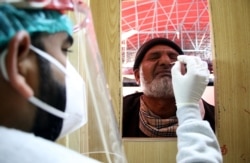President Vladimir Putin praised Russia's naval capabilities during a large warship parade in the port city of St. Petersburg, which drew throngs of spectators despite high infection rates and record deaths from the coronavirus.
"The Russian Navy today has everything it needs to guarantee the protection of our country and our national interests," Putin said on July 25 on the sidelines of the annual parade of navy vessels.
"We can detect underwater, surface, or aerial enemies and target them if a lethal strike is necessary," Putin said.
Mass events are prohibited in St. Petersburg and other parts of Russia due to a vicious wave of the pandemic caused by the highly infectious Delta variant and a sluggish vaccination campaign.
Despite the restrictions, local media reported thousands of people came to watch the parade. Many spectators did not wear masks.
RFE/RL's Coronavirus Coverage
Features and analysis, videos, and infographics explore how the COVID-19 pandemic is affecting the countries in our region.
Similar scenes were reported in the Crimean port city of Sevastopol, where another naval parade was held by Russia's Black Sea Fleet.
Thousands of residents packed together to watch the naval parade despite Sevastopol being under coronavirus restrictions.
Russia seized the region from Ukraine in 2014.
Russia is reporting a seven-day average of nearly 24,000 coronavirus infections and 766 daily deaths.
The total number of cases recorded since the pandemic began in Russia is over 6 million, out of a total population of around 144 million. The number is considered an undercounting of the true extent of the pandemic.
The national death toll linked to COVID-19 stands at 153,095, according to the country's coronavirus task force. However, Russia's statistics agency has recorded around 428,000 excess deaths from April 2020 to May 2021, suggesting the scale of the pandemic is far greater.
In June, Russia began to introduce compulsory vaccination of some workers and imposed restrictions on the unvaccinated. Only 16 percent of the population is fully vaccinated.

